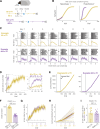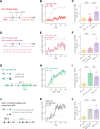This is a preprint.
Reward timescale controls the rate of behavioural and dopaminergic learning
- PMID: 37034619
- PMCID: PMC10081323
- DOI: 10.1101/2023.03.31.535173
Reward timescale controls the rate of behavioural and dopaminergic learning
Abstract
Learning the causes of rewards is necessary for survival. Thus, it is critical to understand the mechanisms of such a vital biological process. Cue-reward learning is controlled by mesolimbic dopamine and improves with spacing of cue-reward pairings. However, whether a mathematical rule governs such improvements in learning rate, and if so, whether a unifying mechanism captures this rule and dopamine dynamics during learning remain unknown. Here, we investigate the behavioral, algorithmic, and dopaminergic mechanisms governing cue-reward learning rate. Across a range of conditions in mice, we show a strong, mathematically proportional relationship between both behavioral and dopaminergic learning rates and the duration between rewards. Due to this relationship, removing up to 19 out of 20 cue-reward pairings over a fixed duration has no influence on overall learning. These findings are explained by a dopamine-based model of retrospective learning, thereby providing a unified account of the biological mechanisms of learning.
Figures






Similar articles
-
Tonic or Phasic Stimulation of Dopaminergic Projections to Prefrontal Cortex Causes Mice to Maintain or Deviate from Previously Learned Behavioral Strategies.J Neurosci. 2017 Aug 30;37(35):8315-8329. doi: 10.1523/JNEUROSCI.1221-17.2017. Epub 2017 Jul 24. J Neurosci. 2017. PMID: 28739583 Free PMC article.
-
Mesolimbic dopamine adapts the rate of learning from action.Nature. 2023 Feb;614(7947):294-302. doi: 10.1038/s41586-022-05614-z. Epub 2023 Jan 18. Nature. 2023. PMID: 36653450 Free PMC article.
-
Cue and Reward Evoked Dopamine Activity Is Necessary for Maintaining Learned Pavlovian Associations.J Neurosci. 2021 Jun 9;41(23):5004-5014. doi: 10.1523/JNEUROSCI.2744-20.2021. Epub 2021 Apr 22. J Neurosci. 2021. PMID: 33888609 Free PMC article.
-
The Dopamine Prediction Error: Contributions to Associative Models of Reward Learning.Front Psychol. 2017 Feb 22;8:244. doi: 10.3389/fpsyg.2017.00244. eCollection 2017. Front Psychol. 2017. PMID: 28275359 Free PMC article. Review.
-
The debate over dopamine's role in reward: the case for incentive salience.Psychopharmacology (Berl). 2007 Apr;191(3):391-431. doi: 10.1007/s00213-006-0578-x. Epub 2006 Oct 27. Psychopharmacology (Berl). 2007. PMID: 17072591 Review.
References
-
- Ebbinghaus Hermann. Memory: A contribution to experimental psychology. Memory: A contribution to experimental psychology. Teachers College Press, New York, NY, US, 1913. doi: 10.1037/10011-000. - DOI
-
- Hintzman Douglas L.. Theoretical Implications of the Spacing Effect. Routledge, 1974. ISBN 978–1-03–272237-5.
-
- Dempster Frank N.. Spacing effects and their implications for theory and practice. Educational Psychology Review, 1(4):309–330, December 1989. ISSN 1573–336X. doi: 10.1007/BF01320097. - DOI
Publication types
Grants and funding
LinkOut - more resources
Full Text Sources
